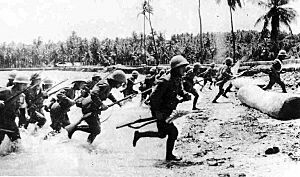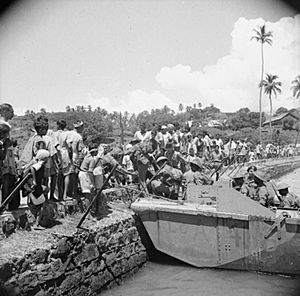Japanese occupation of the Andaman and Nicobar Islands facts for kids

The Japanese occupation of the Andaman and Nicobar Islands happened in 1942 during World War II. The Andaman and Nicobar Islands are a group of 139 islands in the Bay of Bengal. They are about 1,250 km (780 mi) from Kolkata and 1,200 km (750 mi) from Chennai. They are also about 190 km (120 mi) from Cape of Nargis in Burma.
Before the war, the British government used these islands as a prison colony for Indian and African political prisoners. Many were held in the famous Cellular Jail in Port Blair. Port Blair is the biggest town and port on the islands. Today, the islands are a special territory of India.
The only important military target on the islands was Port Blair. The British had a small army there. It included about 300 Sikh soldiers and 23 British officers. In January 1942, more soldiers from the Gurkhas joined them. But after the city of Rangoon fell on March 8, the British knew they could not defend Port Blair. So, on March 10, the Gurkhas left the islands.
Contents
Japanese Invasion Force
The Japanese wanted to protect their sea routes. So, they sent a large force to take over the islands. This force included many ships and soldiers.
They had a main fleet with a flagship cruiser called Chokai. They also had an aircraft carrier, Ryūjō, and several heavy cruisers like Kumano and Mogami. Many destroyers were also part of this group.
Closer to the islands, there was another group of ships. This included a light cruiser, Sendai, and more destroyers.
The actual invasion force had a light cruiser, Yura, and nine transport ships. These ships carried soldiers from the 18th Infantry Division. Other ships included a training cruiser, Kashii, and ships for clearing mines. An air unit with seaplanes also supported the invasion.
Japanese Takeover
Port Blair was taken by the Japanese on March 23, 1942. The British soldiers did not fight back. They were disarmed and held as prisoners. Many of the Sikh soldiers later joined the Indian National Army. The British officers were sent to Singapore as prisoners of war. The main British leaders, like Chief Commissioner Waterfall, were also imprisoned.
The Japanese let the prisoners out of the jail. One of them, Pushkar Bakshi, started helping the Japanese. The islands were then put under the control of Colonel Bucho of the Indian National Army. Some Indian officials were given more important jobs.
The Japanese also brought in their own air force to defend the islands. This included fighter planes and flying boats. About 600 Japanese soldiers were stationed on the islands. They, along with the local police (now controlled by Japan), kept order.
Key Japanese Army Leaders in Andaman and Nicobar
- Yoshisuke Inoue: Commander of the 35th Independent Mixed Brigade on the Andaman Islands.
- Toshio Itsuki: Commander of the 36th Independent Mixed Brigade on the Nicobar Islands.
- Hideo Iwakuro: Japanese officer who worked with the Indian National Army.
- Major-General Saburo Isoda: Another Japanese officer who worked with the Indian National Army.
The Provisional Government of Free India
On December 29, 1943, the islands were officially given to the Azad Hind government. This government was led by Subhas Chandra Bose. Bose visited Port Blair and raised the flag of the Indian National Army.
During his visit, the Japanese kept Bose away from the local people. People tried to tell him about the suffering on the islands. They wanted him to know that many Indian nationalists were being treated badly in the Cellular Jail. It seems Bose did not know about these problems. Some people felt he did not help his own people enough.
After Bose left, the Japanese still had real control over the islands. The power of the Provisional Government of Free India was mostly just on paper. The islands were renamed "Shaheed" (meaning "martyr") and "Swaraj" (meaning "self-rule").
Bose appointed General A. D. Loganathan as the governor of the islands. But Loganathan had very little power. He later said he only had full control over the education department. The Japanese kept control of the police. Because of this, he refused to be responsible for other parts of the government.
He could not stop the worst event of the occupation. This was the Homfreyganj massacre on January 30, 1944. In this terrible event, 44 Indian civilians were shot by the Japanese. They were suspected of spying. Many of them were part of the Indian Independence League. This government was supposed to rule the islands until the British took them back in 1945. But in reality, not much changed.
The Final Year of Occupation
By 1945, food became very scarce. The Japanese took extreme measures. Between 250 and 700 people from the Aberdeen area of South Andaman were sent to an uninhabited island. They were supposed to grow food there.
One survivor, a former prisoner named Saudagar Ali, said that at least half of the people drowned or were eaten by sharks. This happened when they were pushed out of boats in the dark. The rest either died of starvation or were killed by Burmese pirates. After the war, a rescue team went to the island. They found only twelve survivors and over a hundred skeletons on the beach.
In total, about 2,000 people on the Andamans died because of the occupation. At least 501 people were treated badly by the Japanese. This number is about 10% of the population of Port Blair before the war. Fewer people died on the Nicobar islands. This was because the Japanese did not have a permanent army there. However, in 1943, they forced many Nicobarese people into labor.
The occupation left a lasting feeling of anger towards the Japanese. It also caused some anger towards those who helped the Provisional Government of Free India. This feeling was strong among the generation who lived through it.
Japanese Vice Admiral Teizo Hara and Major-General Tamenori Sato surrendered the islands. They gave them to Lt Col Nathu Singh on August 15, 1945. This happened on board the British warship HMS Sandbar. The official signing ceremonies took place later. The surrender of a Japanese admiral and general to Indian forces in the Andamans marked the end of World War II there. A memorial was later built in Port Blair to remember this surrender.
Brigadier J.A. Salomons and Chief Administrator Mr. Noel K. Patterson officially took control of the islands. This happened on October 7, 1945, at a ceremony in Port Blair.
See also
- Battle of the Malacca Strait
- Cocos Islands mutiny
- India in World War II


